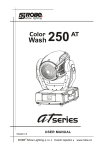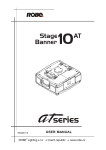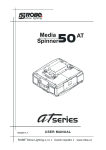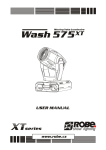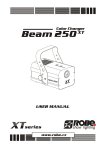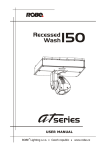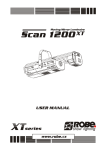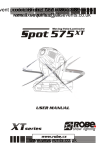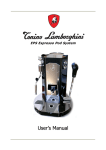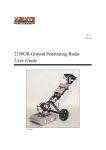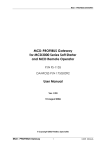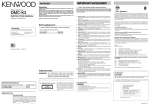Download "user manual"
Transcript
Version 2.2
1
FiberBeam 250 AT
Table of contents
1. Safety instructions ......................................................................................................... 3
2.Operating determinations............................................................................................... 4
3. Description of the device............................................................................................... 5
4. Installation....................................................................................................................... 6
4.1Fitting the lamp............................................................................................................ 6
4.2 Lamp adjustment ....................................................................................................... 6
4.5 Connection to the mains ............................................................................................ 7
4.6 Installing the fiber optic cable..................................................................................... 7
4.7 Rigging the fixture ...................................................................................................... 7
4.8 DMX-512 connection/connection between fixtures .................................................... 8
5. Controller operation ....................................................................................................... 9
5.1 DMX addressing......................................................................................................... 9
5.2 Remotely controllable functions ................................................................................. 9
6. Stand - alone operation................................................................................................ 10
7.FiberBeam 250 - DMX Protocol,version 1.0 ................................................................ 11
8.Control menu map......................................................................................................... 12
9. Control menu ............................................................................................................... 14
9.1 Fixture Address ....................................................................................................... 14
9.2 Slave control ........................................................................................................... 14
9.3 Fixture informations.................................................................................................. 14
9.4 Personality ............................................................................................................... 15
9.5 Lamp On/Off ............................................................................................................ 16
9.6 Test sequences........................................................................................................ 16
9.7 Stand-alone setting ................................................................................................. 16
9.8 Reset functions ........................................................................................................ 17
9.9 Special functions ...................................................................................................... 17
10. Error and information messages .............................................................................. 18
11. Technical specifications ............................................................................................ 19
12. Maintenance and cleaning......................................................................................... 20
2
CAUTION!
Keep this device away from rain and moisture!
Unplug mains lead before opening the housing!
FOR YOUR OWN SAFETY, PLEASE READ THIS USER MANUAL CAREFULLY
BEFORE YOU INITIAL START - UP!
1. Safety instructions
Every person involved with installation and maintenance of this device have to:
- be qualilfied
- follow the instructions of this manual
CAUTION!
Be careful with your operations.
With a high voltage you can suffer
a dangerous electric shock when touching the wires!
This device has left our premises in absolutely perfect condition. In order to maintain this condition and to ensure a safe operation, it is absolutely necessary for the user to follow the safety instructions and warning notes
written in this manual.
Important:
The manufacturer will not accept liability for any resulting damages caused by the non-observance of this
manual or any unauthorized modification to the device.
Please consider that damages caused by manual modifications to the device are not subject to warranty.
Never let the power-cord come into contact with other cables! Handle the power-cord and all connections with
the mains with particular caution!
Make sure that the available voltage is not higher than stated on the rear panel.
Always plug in the power plug least. Make sure that the power switch is set to OFF-position before you connect
the device to the mains. The power-plug has to be accessable after installing the device.
Make sure that the power cord is never crimped or damaged by sharp edges. Check the device and the powercord from time to time.
Always disconnect from the mains, when the device is not in use or before cleaning it. Only handle the powercord by the plug. Never pull out the plug by tugging the power-cord.
This device falls under protection class I. Therefore it is essential to connect the yellow/green conductor to
earth.
The electric connection, repairs and servicing must be carried out by a qualified employee.
Do not connect this device to a dimmer pack.
Do not switch the fixture on and off in short intervals as this would reduce the lamp’s life.
During the initial start-up some smoke or smell may arise. This is a normal process and does not necessarily
mean that the device is defective.
Do not touch the device’s housing bare hands during its operation (housing becomes hot)!
For replacement use lamps and fuses of same type and rating only.
CAUTION ! EYEDAMAGES !
Avoid looking directly into the light source
(meant especially for epileptics) !
3
2.Operating determinations
This device is a moving-head spot for creating decorative effects and was designed for indoor use only.
If the device has been exposed to drastic temperature fluctuation (e.g. after transportation), do not switch it on
immediately. The arising condensation water might damage your device. Leave the device switched off until
it has reached room temperature.
Never run the device without lamp!
Do not shake the device. Avoid brute force when installing or operating the device.
Never lift the fixture by holding it at the projector-head, as the mechanics may be damaged. Always hold the
fixture at the transport handles.
When choosing the installation spot, please make sure that the device is not exposed to extreme heat, moisture
or dust. There should not be any cables lying around. You endanger your own and the safety of others!
The minimum distance between light-output and the illuminated surface must be more than 0.8 meters.
Make sure that the area below the installation place is blocked when rigging, derigging or servicing the fixture.
Only operate the fixture after having checked that the housing is firmly closed and all screws are tightly fastened.
The lamp must never be ignited if the objective-lens or any housing-cover is open, as discharge lamps may
explose and emit a high ultraviolet radiation, which may cause burns.
The maximum ambient temperature must never be exceeded. Otherwise, the lamp is switched off and the
fixture is out of operation for 5 minutes.
CAUTION!
The lens has to be replaced when it is obviously damaged,
so that its function is impaired, e. g. due to cracks or deep scratches!
Operate the device only after having familiarized with its functions. Do not permit operation by persons not
qualified for operating the device. Most damages are the result of unprofessional operation!
CAUTION!
The lamp has to be replaced when it is damaged
or deformed due to the heat!
Please use the original packaging if the device is to be transported.
Please consider that unauthorized modifications on the device are forbidden due to safety reasons!
If this device will be operated in any way different to the one described in this manual, the product may suffer
damages and the guarantee becomes void. Furthermore, any other operation may lead to dangers like shortcircuit, burns, electric shock, burns due to ultraviolet radiation, lamp explosion, crash etc.
4
3. Description of the device
1 - Port for fiber optic cable
2 - Zoom-screw
3 - Focus-screw
4 - Bracket
5 - Adjusting bracket screw
6 - Housing
7 - Fastening screws
Rear panel:
1 - DMX output
2 - DMX input
3 - Power cable
4 - Fuseholder
5 - Power switch
6 - Control Board
5
4. Installation
4.1Fitting the lamp
DANGER !
Install the lamps with the device switched off only.
Unplug from mains before !
To insert the lamp ( MSD 250/2, GY-9,5) open the housing by loosening the fastening screws at the side panels
and by removing the focus-screw and zoom-screw.
If changing the lamp, remove the old lamp from the socket. Insert the new lamp to the socket.
Do not install a lamp with a higher wattage! A lamp like this generates temperatures the device is not designed
for.
Damages caused by non-observance are not subject to warranty. Please follow the lamp manufacturer‘s notes!
Do not touch the glass-bulb bare hands during the installation! Make sure that the lamp is installed tightly into
the lampholder system.
Adjust the optimal distance 1-1.5 mm from the lens by turning the screw „A” (see the drawings „Lamp adjustment” below).
Replace the housing cover and tighten the screws.
Reclose the top cover of the head and tighten the 4 fastening screws.
Before striking the lamp, reset the “LAti/rSEt” and “LASt/rSEt”counters in the “InFO” menu on the control
panel, by pressing the “Up” and “Down” buttons in one time and then confirming with the “Enter”-button.
Do not operate this fixture with opened housing-cover!
4.2 Lamp adjustment
Correct
Incorrect
Keep optimum
distance to lens!
Optimum
distance
1 - 1.5mm
Screws „A“
Screws „B“
The FIBERBEAM250 XT lampholder is aligned at the factory. Due to differences between lamps, fine adjustment may improve light performance.
Strike the lamp and focus the light on a flat surface (wall). As the optimum distance of lamp from lens was
adjusted during the installing or changing the lamp (by turning the screw „A”), it is necessary to adjust only the
second position by turning the screw „B”, in order to center the hot-spot (the brightest part of the beam).
If the Hot Spot seems to be too bright, you can lower its intensity by moving the lamp closer to the reflector. Do
so by turning srew „A” until the light is evenly distributed.
If the light on the edge seems to be brighter as in the center, the lamp is too close at the reflector. In this case,
6
you need to move the lamp away from the reflector until the light is evenly distributed and the beam appears
bright enough.
4.5 Connection to the mains
Verify the power supply settings before applying power!
Connect the fixture to the mains with the enclosed power plug.If you need to install other power plug on the
power cable,follow the identification table below.
The earth has to be connected!
Do not connect the fixture to a dimmer system!
The occupation of the connection-cables is as follows:
Cable (EU)
Cable (US)
Pin
International
Brown
Black
Live
L
Light blue
White
Neutral
N
Yellow/Green
Green
Earth
4.6 Instaling the fiber optic cable
Push the cable in the adaptor ferrule in the port for the fiber optic cabel and secure it by the screw in the port.
4.7 Rigging the fixture
Danger of fire !
When installing the device, make sure there is no highly inflammable
material (decoration articles, etc.) in between a distance of min. 0.5 m.
Attach the mounting-bracket to the projector by using the enclosed fixation screws.
Mount the projector with the mounting-bracket to your trussing system. The hole in the mounting bracket has
a diameter of 10 mm.
For overhead use, always install a safety-rope that can hold at least 10 times the weight of the fixture.
Adjust the desired inclination-angle via the mounting-bracket and fix the bracket-screws tightly.
Make sure that the device is fixed properly! Ensure that the structure
to which you are attaching the projectors is secure.
For overhead use, fit a safety chain or cord.
7
4.8 DMX-512 connection/connection between fixtures
The fixture is equipped with 3-pin XLR sockets for DMX input and output. Only use a shielded twisted-pair cable
designed for RS-485 and 3-pin XLR-plugs and connectors in order to connect the controller with the fixture or
one fixture with another.
DMX - output
DMX-input
XLR mounting-sockets (rear view):
XLR mounting-plugs (rear view):
1 - Ground
2 - Signal (-)
3 - Signal (+)
1 - Ground
2 - Signal (-)
3 - Signal (+)
If you are using the standard DMX controllers, you can connect the DMX output of the controller directly with
the DMX input of the first fixture in the DMX-chain. If you wish to connect DMX-controllers with other XLR-outputs, you need to use adapter-cables.
Set main
functions
Set special
functions
Set main
functions
Adjust lamp position
by turning screws A and B
Set special
functions
B
A
POWER
Use the [UP] and [DOWN] keys
to move within the menu.
To select a function or
special function press [ENTER].
To escape a function or menu
press [MENU].
FUSE
T3,15A@230V
MENU ENTER
out
pin1: gnd
pin2: data pin3: data +
UP
Use the [UP] and [DOWN] keys
to move within the menu.
To select a function or
special function press [ENTER].
To escape a function or menu
press [MENU].
FUSE
T3,15A@230V
MENU ENTER
out
factory set main at:
Serial number:
POWER
POWER
SUPPLY
UP
Serial number:
pin1: gnd
pin2: data pin3: data +
Made in Czech republic
Made in Czech republic
POWER
Use the [UP] and [DOWN] keys
to move within the menu.
To select a function or
special function press [ENTER].
To escape a function or menu
press [MENU].
FUSE
T3,15A@230V
MENU ENTER
out
factory set main at:
POWER
SUPPLY
B
Do not allow the lamp
to touch lens!
LAMP: MSD/HSD 250W MH
BASE: GY-9,5
POWER: 400VA
DOWN
in
Adjust lamp position
by turning screws A and B
A
Do not allow the lamp
to touch lens!
LAMP: MSD/HSD 250W MH
BASE: GY-9,5
POWER: 400VA
DOWN
in
Set special
functions
B
A
Do not allow the lamp
to touch lens!
LAMP: MSD/HSD 250W MH
BASE: GY-9,5
POWER: 400VA
Set functions
main
Adjust lamp position
by turning screws A and B
pin1: gnd
pin2: data pin3: data +
UP
DOWN
in
factory set main at:
Serial number:
POWER
SUPPLY
Made in Czech republic
Controller operation
Master/slave operation
Building a serial DMX-chain:
Connect the DMX-output of the first fixture in the DMX-chain with the DMX-input of the next fixture. Always
connect one output with the input of the next fixture until all fixtures are connected.
Caution: At the last fixture, the DMX-cable has to be terminated with a terminator. Solder a 120 Ω resistor
between Signal (–) and Signal (+) into a 3-pin XLR-plug and plug it in the DMX-output of the last fixture.
Building a master/slave-chain:
Connect the DMX-output of the master fixture in the data-chain with the DMX-input of the first slave. Always
connect output with the input of the next slave until all slaves are connected (up to 9 fixtures).
Caution:It’s necessary to insert the XLR termination plug (with 120 Ohm) into the input of the master fixture
and into the output of the last slave fixture in the link in order to ensure proper transmission on the data link.
.
8
5. Controller operation
The fixtures are individually addressed on a data link and connected to the controller.The fixtures respond to
the DMX signal from the controller.
5.1 DMX addressing
The control panel on the front panel of the fixture allows you to assign the DMX fixture address, which is defined
as the first channel from which the FiberBeam 250 will respond to the controller.
If you set, for example, the address to channel 11, the FiberBeam 250 will use the channel 11 to 14 for control
Please, be sure that you don’t have any overlapping channels in order to control each FiberBeam 250 correctly
and independently from any other fixture on the DMX data link.
If two, three or more FiberBeam 250 are addressed similarly, they will work similarly.
For address setting, please refer to the instructions under "Addressing"(menu "A001").
Controlling:
After having addressed all FiberBeam 250 , you may now start operating these via your lighting controller.
Note:After switching on, the FiberBeam 250 will automatically detect whether DMX 512 data is received or not.If
there is no data received at the DMX-input, the display will start to flash "A001" with actually set address.
This situation can occur if:
- the 3 PIN XLR plug (cable with DMX signal from controller) is not connected with the input of the FiberBeam
250
- the controller is switched off or defective, the cable or connector is defective or the signal wires are swap in
the input connector.
Note:It’s necessary to insert the XLR termination plug (with 120 Ohm) to the last fixture in the link in order to
ensure proper transmission on the DMX data link.
5.2 Remotely controllable functions
Lamp
The FiberBeam 250 is to be operated with a Philips MSD 250/2 lamp.
A relay inside of the FiberBeam 250 allows you to switch on and off the lamp via the control panel or via your
DMX-controller without affecting the rest of the lighting.
To switch On/Off the lamp, please refer to "Lamp On/Off " (menu LAMP).
Note:It is also important to note, that the discharge lamp is cold restrike types, that means, that they have to be
cold before re-striking. For this reason, you have to wait 5 minutes (max. speed of fan must be adjusted) after
having switched Off the lamp before you can switch it back On again. If you try to switch On the lamp within 5
minutes after having switched it Off, the FiberBeam 250 will store this information and automatically ignite the
lamp when the 5 minutes period has expired. The message "HEAt" will appear on the control panel display of
the FiberBeam 250. If the ignition of the lamp is seven times unsuccessful, on the display will appear "LA.Er",
meaning that the lamp could be damaged or even missed, or there could be a failure on the ignitor or ballast.
Colour wheel
This wheel contains 11 dichroic filters and an open.
Effect wheel
The effect wheel includes,3 colours and UV filter,3200K and 5600K correction filters.
Dimmer/Shutter/Strobe
Dimming is provided by the combined mechanical dimmer/shutter unit. This unit may also be used for strobe
effect .
9
6. Stand - alone operation
The fixtures on a data link are not connected to the controller but can execute pre-set programs which can be
different for every fixture.To set the program to be played,see the "Stand-alone setting" ( menu "St.AL.").
"Stand-alone operation" can be applied to the single fixture (the fixture may be set to the master /slave mode
or controller mode ) or to multiple fixtures operating synchronously.
Synchronous operation of multiple fixtures requires that they must be connected on a data link and one of them
is set as a master (master mode) and the rest as the slaves (slave mode).The slaves are assigned to SLA1SLA9 and on the certain slave address can be connected only one fixture.To set the fixture as the master or
slave , see the "Addressing" (menu "A001").
If the master fixture runs a reset,switches On/Off the lamp or plays test(program) ,all slaves will execute
these acts too (e.g. if the master fixture has switched the lamp off,no slaves can switch the lamp on)!
The master fixture starts simultaneous program start in the other slave fixtures.All fixtures have a definite, synchronized starting point when playing back their programs.The number of running program is the same in all
slaves and depends on the master's choice (menu "St.AL." ).Every fixture runs its program repeatedly ,starting
the program step No.1 when requested by the master .
For example:
If the slave fixture has a shorter program length, it will continously repeat its program until the master fixture
finishes its own program and restarts its program running (slave 1- prog.step 3 will not be finished).
If the slave fixture has a longer program length, it will restart at prog. step 1 before it completes all its
prog.steps
(slave 2 - prog.step 5 will not be played)- see the picture bellow.
Restart
Starting point
Note:Disconect the fixtures from the DMX controller before master/slave operating ,otherwise data collisions
can occur and the fixtures will not work properly!
10
7.FiberBeam 250 - DMX Protocol,version 1.0
Channel
1
2
3
4
Value
Function
Type of control
0
10
21
32
42
53
64
74
85
96
106
117
128-255
Colour wheel
Open/White
Turquoise
Red
Cyan
Light green
Magenta
Light blue
Yellow
Green
Pink
Blue
Orange
Rainbow effect from fast to slow
proportional
proportional
proportional
proportional
proportional
proportional
proportional
proportional
proportional
proportional
proportional
proportional
proportional
0-20
21-42
43-63
64-84
85-106
107-127
128-148
149-235
236-255
Effect wheel
Full open
Colour temperatute correction filter 3200K
Colour temperatute correction filter 5600K
Magenta
Cyan
Yellow
UV filter
Dots- positioning
Dots- shaking from fast to slow
step
step
step
step
step
step
step
step
proportional
0-127
128-139
140-148
149
150-219
220-229
230-239
240-255
Shutter,Strobe
Open,Fan speed from max. to min.
Open,Switch on the lamp,Reset
Closed
Closed in reverse position
Strobe effect from slow to fast
Open position
Shutter is in half position of the beam,Lamp Off after 3 s.
Open position
proportional
step
step
step
proportional
step
step
step
0
1-126
127
128-192
193-254
255
Dimmer
Closed,light is off
Smooth dimming from black to full open
Full open - sharp beam
Smooth dimming from full open to black
Smooth dimming from black to full open
Full open-frost(wash) light
step
proportional
step
proportional
proportional
step
11
8.Control menu map
Default settings=Bold print
A001
dM.Ad.
MA.SL.
001
:
503
d.AbL
MASt.
SLA.1
:
SLA.9
SL.Ct.
InFo
Po.ti.
La.ti.
LA.St.
Hi.tE.
totl
rSEt
totl
rSEt
totl
rSEt
totl
rSEt
tEMP.
DM.In.
VErS.
PErS.
LA.Pr.
dISP.
Colo (0-255)
:
dim (0-255)
LA.Au.(On,Off)
d.L.OF.(On,Off)
dM.On (On,Off)
dM.OF.(On,Off)
turn (On,Off)
d.On (On,Off)
d.Int.(20...100)
FAn.S. (Auto,HIGH,rEG,LoHi,LoOF)
dF.SE.
12
LAMP
(On,Off)
tESt
St.AL.
Auto
PLAY
Edit
Off
tESt
PrG.1
PrG.2
PrG.3
tESt
PrG.1
PrG.2
PrG.3
PrG.1
PrG.2
PrG.3
St.01
:
St.99
rESE.
SPEC.
MAnu.
CodE
AdJ.
Colo (Col.1,...Col.16)
:
dimr (dim0...dim4,dimC)
Colo (0-255)
:
F.CAL
Colo. (0-255)
EFFE (0-255)
A.rES.
13
Colo (0-255)
:
S.tim.(0.1-25.5) (s)
COPY
9. Control menu
The control panel situated on the rear panel of the fixture offers several features. You can simply set the DMX
address,read the number of the lamp or unit hours, switch On and Off the lamp, run test, make a reset and also
use many functions for setting fixture behaviour.
Control elements on the control board:
[MENU] button-leaves menu without saving changes.
[ENTER] button- enters menu,confirms adjusted values and leaves menu.
[UP] button and[DOWN] button- moves between menu items on the the same level, sets values.
After switching the fixture on,the display shows the initial screen:
Use [UP],[DOWN] to browse through the menu. To select a function or submenu,press [ENTER].
9.1 Fixture Address
Use this menu to set the DMX address of the fixture or set the fixture as a Master (Slave).
dM.Ad. --- DMX addressing.Select this submenu to set DMX start address.
MA.SL. --- Master/slave addressing.Select this submenu to set the fixture as a Master or Slave (Slave1Slave 9).Option "d.AbL" deactivates master/slave setting.
9.2 Slave control
This function allows you to control the slaves from the master's control panel in a master/slave operation.
Select this function from the main menu and press [ENTER].Browse the list of all connected slaves ("SL.C.1"
- "SL.C.9") by pressing [UP] or [DOWN].Select the desired slave and press [ENTER]-button.The matching slave
control panel is available from the master control panel.
Note:This function is available from the master fixture only.
9.3 Fixture informations
Use this menu to read an useful information about the fixture.
Po.ti. ---Power on time.Select this submenu to read the number of operation hours.
totL --- The function shows the total number of the operation hours since the FiberBeam 250
has been fabricated.
rSEt --- The function shows the number of the operation hours that the FiberBeam 250
has been powered on since the counter was last reset.In order to reset
this counter to 0 you have to hold [UP] and[DOWN ] and press the [ENTER].
La.ti. --- Lamp on time.Select this submenu to read the number of the operation hours with the lamp on.
14
totL --- The function shows the total number of the operation hours with the lamp on since
the FiberBeam 250 has been fabricated.
rSEt --- The function shows the number of the operation hours with the lamp on that the
FiberBeam 250 has been powered on since the counter was last reset.In order to
reset this counter to 0 you have to hold [UP] and[DOWN ] and press the [ENTER].
LA.St. --- Lamp strikes.Select this submenu to read the total number of the lamp strikes.
totL --- The function shows the total number of the lamp strikes since the FiberBeam 250
has been fabricated.
rSEt --- The function shows the number of the lamp strikes since the counter was last
reset.In order to reset this counter to 0 you have to hold [UP] and[DOWN ] and press
[ENTER].
Hi.tE ---Max.fixture head temperature.Select this submenu to read the max. fixture head temperatures
(°C).
totL - The function shows the max.temperature of the head inside since
the FiberBeam 250 has been fabricated.
rSEt - The function shows the maximum temperature of the head inside
since the counter was last reset.In order to reset the counter to 0 you have
to hold [UP] and[DOWN ] and press the [ENTER].
tEMP ---Current fixture head temperature.Select this submenu to read the current fixture head temperature
(°C). Temperatures below 74°C are not critical. 74° C and more lead to the lamp being switched off.Please
note that the outside temperature should not exceed 40° C.
DM.In.--- Readout of DMX values.Select this function to read DMX values (0-255) of each channel received
by the fixture.
Colo a colour wheel
EFFE an effect wheel
Stro. a shutter,strobe
dimr a dimmer
VErS. --- Software version.Select this function to read the software version of the display module.
9.4 Personality
Use this menu to to modify FiberBeam 250 operating behavior.
LA.Pr. --- Lamp presetting.Select this menu to change the lamp "behaviour".
LA.Au. --- Select this function to turn the lamp on automatically after switching the
fixture on.
d.L.OF. --- Select this function to switch off the lamp via DMX.
dM.On --- This function allows you to strike the lamp automatically after 26 seconds if DMX
signal is present on the data link.If the ignition is unsuccessfull (e.g.lamp is too hot),the
fixture will try to ignite the lamp after next 26 s.This process will repeat until the lamp lights.
dM.OF. --- This function allows you to switch Off the lamp automatically after 2 minutes if
DMX signal is missing on the data link.
En.Sn. --- Switching on/of the lamp light sensor.Select this function to switch the lamp light sensor on or
off.The option"On" is for the standard operation.
Important: The option"Off" is for "emergency operation" only if the lamp light sensor is defective and you will
wait for a service intervertion! If the lamp light sensor is switched off and at switching the lamp on the electronics will still try to ignite the lamp until it shines (even when the lamp is damaged or absent), on this
account some electronics parts could be damaged!
DiSP. --- Display adjusting.This function allows you to change the display settings.
turn --- Select this function to turn the display by 180°.
d.On --- This function allows you to keep the display on or to turn off automatically 2 minutes
15
after last pressing any button on the control panel.
d.Int. --- Select this function to adjust the display intensity (20-min.,100-max.).
Fan.S. --- Fan speed operating modes.By using this function you can choose 3 types of the fans speed operating modes.
Auto --- The fan automatically raises its speed in order to control inside temperature
of the head.
HIGH --- The cooling fan works on max. speed (max. cooling).
reg --- This mode is similar to "Auto" but the initial level of the fan speed can be adjusted by
DMX valus on the channel 3 (see DMX protocol).
LoOF--the fan keeps the adjusted low speed until the temperature exceeds max. inside temperature, then the FiberBeam 250 AT automatically switches Off the lamp.
LoOF--the fan keeps the adjusted low speed until the temperature exceeds max. inside temperature, then the FiberBeam 250 AT automatically switches to HIGH speed.
dF.SE. --- Default Settings .Select this option to reset all fixture personalities to the default values.
9.5 Lamp On/Off
Use this option in order to switch on/off the lamp.It is also important to note, that the lamp is cold restrike type,
that means, that it has to be cold before striking.
9.6 Test sequences
Use this menu to to run a special demo-test sequences without an external controller, which will show you some
possibilities of using FiberBeam 250.
9.7 Stand-alone setting
Use this menu to set options for stand-alone mode as a selection of the playing program,programming and
modifying current programs.
Auto --- Presetting playback.This function allows you to select the program which will be played in the standalone mode
after switching the fixture on.Selected program will be played continuously in a loop.
d.Abl --- The option disables "Auto" function.
tESt --- The option will start built-in test program.
PrG. 1 --- The option will start created program No.1
PrG. 2 --- The option will start created program No. 2
PrG. 3 --- The option will start created program No. 3
Note:If the fixture operates in the controller mode ( DMX controller is connected) and any program from this
menu is selected ,in this case the fixture will not respond to the DMX controller after switching on and will play
selected program.
PLAY --- Playing program.Select this menu to run a bilt-in program or the 3 freely-programmable programs
in a loop.
tESt --- The option starts built-in test program.
PrG.1 --- The option starts created program No. 1
PrG.2 --- The option starts created program No. 2
PrG. 2 --- The option starts created program No. 3
16
Select the program you wish and press [ENTER].The selected program starts running.By Pressing [ENTER]
again is possible to pause the program running.
Edit --- Editing program.Select this menu to edit or create the program.The FiberBeam 250 has one builtin program and the 3 free programs,each up to 99 steps.Each program step has a step time.Step time-the
time,during which effects last in the current step.
If the fixture is set as a master ,then you may edit any program in the slaves.You can't edit programs on the
slave fixtures from their control panels if the master fixture is switched on and connected to the slaves (editing
is possible by the master control panel only).
Procedure:
1. Press [UP] or [DOWN] to select the program you want to edit ("PrG.1" - "PrG.3") and press [ENTER].
2. Press [UP] or [DOWN] to select the desired fixture ("MASt." - "SLA.9") and press [ENTER]-button.
3. Press [UP] or [DOWN] to select the desired program step ("St.01" - "St.99") and press [ENTER]-button.
4 Press [UP] or [DOWN] to select the desired item and press [ENTER]-button.Now you can edit by [UP] o r
[DOWN] buttons the DMX value (0-255) for selected item:
P.End. - a total number of the program steps (value 1-99).This value you must set before start
programming(e.g. if you want to create program with the 10 steps,set P.End=10).
Colo a colour wheel
EFFE an effect wheel
Stro. a shutter,strobe
dimr a dimmer
S.tim. a step time,value 0,1-25,5 seconds
COPY. - copying the current prog. step to the next prog. step .If the last prog.step is copied to the
next prog. step ,parameter "P.End" is increased about one by itself (except step 99).
5. Press [ENTER]-button to confirm adjusted value .
6. Press [MODE]-button,select next prog. step and repeat this procedure (steps 4 - 6).
9.8 Reset functions
This option enables the FiberBeam 250 to index all effects (functions) and return to their standard positions.
9.9 Special functions
Use this menu for special services like adjusting lamp or adjusting effects.
MAnu. --- Manual control of the effects..Select this menu to call up presetted positions of the channel effects.
CodE --- Code.This function contains identification hexadecimal code (0000-FFFF) for the fixture, which is
used for the master/slave operation.
AdJ. --- Effect adjustment.By this function you can calibrate and adjust the effects to their standard/right
positions.Disconect the DMX controller from the fixture and select "AdJ." menu.The display shows step by step
effects by which you can adjust the fixture to the required position before the function calibration(DMX controller
must be disconnected).When the positioning is finished ,select "F.CAL." and press [ENTER].
1. Calibration via the control board
Disconnect DMX controller from the fixture.Press [ENTER] and use [UP] and [DOWN] in order to display the
following items: "Colo.,EFFE" for very smooth function calibration. Select one of them, press [ENTER] and use
the [UP] and [DOWN] in order to adjust their right value from 0 to 255. Then press [ENTER] to confirm or [MENU]
to cancel and return to the menu. This can be repeated for each calibration parameter if it is required.
When the calibration is finished, it is necessary to use the "A.rES" function in order to write the calibration values to the memory (EPROM) and to make a reset in order to check the newly adjusted positions of the colour
17
and effect wheels. When the reset of the fixture is finished, the display will show the "F.CAL" message. Press
[ENTER] to repeat the calibration or [MENU] to return to the "AdJ." menu.
2. Calibration via the external controller
Press [Enter] and the [Up] or [Down] key in order to display the following messages: „CoL, EFEC” - calibration
parameters. Select one of them and press [Enter].
Now you can calibrate the colour and effect wheel by your controller. The DMX calibration protocol is described
below:
Channel
Function
1-Colour wheel
Standard protocol
2-Effect wheel
Standard protocol
3-Shutter
Standard protocol
4-Dimmer
Standard protocol
5
Smooth colour wheel movement
6
Smooth effect wheel movement
After having calibrated required functions press [Enter] to confirm (or [Mode] to cancel and return to the menu
without reset by the “ArES” function) and use the “ArES” function in order to write the calibration values to
the memory (EEPROM) andto make a reset in order to check the new adjusted positions of the colour and
effect wheels .
10. Error and information messages
HEAt
This message appears if you try to switch on the lamp within 5 minutes after having switched it off (the lamp is
too hot). The message will appear on the display if the lamp doesn't ignite within 28 seconds. The FiberBeam
250 will store this information and automatically ignite the lamp when the 5 minutes period has expired.
Caution: The message is disabled if the lamp light sensor (function "En.Sn.") is switched Off (only if the lamp
was turned Off and On within 5 minutes,the message "HEAt" will appear).
LA.Er.
The ignition of the lamp is seven times unsuccessful (the "HEAt" message appeared six times before), and the
display shows "LA.Er", meaning that the lamp could be damaged or even missed, the fixture is overheating (this
can occur if the ambient temperature is 40° C or more) or there could be a failure on the ignitor or ballast.
Please place or replace the lamp, check the ambient temperature or contact your dealer if the situation was
not caused by the lamp.
Caution: The message is disabled if the lamp light sensor (function "En.Sn.") is switched Off.
Mb.Er.
This messsage informs you that the main PCB does not communicate correctly with the Control Board.
Co.Er. (color wheel error)
This messsage will appear after the reset of the fixture if the magnetic-indexing circuit malfunctions (sensor
failed or magnet missing) or the stepping-motor is defective (or its driver circuit on the main PCB). The colorwheel is not located in the default position after the reset.
EF.Er. (effect wheel error)
This message will appear after the reset of the fixture if the magnetic-indexing circuit malfunctions (sensor failed
or magnet missing) or the stepping-motor is defective (or its driver circuit on the main PCB). The effect wheel
is not located in the default position after the reset.
Ft.Er.
This error message informs you that the fixture was overheating (occured if the ambient temperature is 40° C
or more) and that the relay switched off the lamp.
Fr.Er.
This message will appear if the frequency of the main is not standard 50 or 60 Hz.This message can appear as
a result of the interference during the lamp starting (if the lamp or igniter is old) or as a result of the interference
by neighbouring devices. In these cases the message does not affect the fixture operating!
Sn.Er.
This message appears if the lamp light sensor is failed.
18
PoEr
This message will appear if the fixture was shortly disconnect from the main.
MA.Er.(Master error)
The message informs you that the fixture was addressed as a master and DMX signal is connected to its
input.Disconnect the DMX controller from fixture's input and address the fixture as the master again.
11. Technical specifications
Power supply:
- Voltage............................208/230/240V AC, 50/60Hz ~
- Fuse................................T 3,15 A@ 230V
- Power consumption..........400VA
Motors:
- 4 high quality stepping-motors controlled by microprocessors
Lamp:
- Philips MSD250/2 GY9.5
Optical system:
- Double condensor lens with high efficiency parabolic mirror
- Mechanic zoom and focus
Colours:
- 11 dichroic-filters plus white
- Effect-wheel with cyan, magenta and yellow for additive colour-mixing
- 2 additional correction-filters for additive colour-mixture (3200K und 5600K)
- 72 colours with 72 half-colours
- Integrated UV-filter
- Colour-wheel with adjustable rotation-speed and rainbow-effect
Effects:
- Dots effects
Dimmer/Strobe:
- Linear mechanical dimmer
- Dimmable from 0 % - 100 %
- Strobe-effect with adjustable speed (1 - 8 flashes per second)
- Frost-filter
Electronics:
- Addressing, special functions setting, effects calibration via control panel with 4-digit LED
display
- Readout fixture and lamp usage, receiving DMX values, temperature, etc
- Built-in analyzer for easy fault finding,error messages
- Remotely switching of the lamp
- Bilt-in demo sequences
- Silent fans cooling, remotely controllable speed of fans
- Self-resetable thermo-fuse
- Digital serial input DMX-512
- Master/slave operation
- Stand-alone operation
- 3 freely programmable programs,each up to 99 steps
- DMX-control via every standard DMX controller
- 4 DMX-channels
19
Channel 1: Colour-wheel
Channel 2: Effect-wheel
Channel 3: Shutter,strobe
Channel 4: Dimmer
Temperatures:
- Maximum ambient temperature : 40° C
- Maximum housing temperature: 80° C
Minimum distances:
- Min.distance from flammable surfaces: 0.5m
Diameter of fiber adaptor ferrule
29.7 mm
Dimensions:
Weight:
13.6 kg
12. Maintenance and cleaning
It is absolutely essential that the fixture is kept clean and that dust, dirt and smoke-fluid residues must not build
up on or within the fixture. Otherwise, the fixture‘s light-output will be significantly reduced. Regular cleaning will
not only ensure the maximum light-output, but will also allow the fixture to function reliably throughout its life.
A soft lint-free cloth moistened with any good glass cleaning fluid is recommended, under no circumstances
should alcohol or solvents be used!
DANGER !
Disconnect from the mains before starting any
maintenance work
The front objective lens will require weekly cleaning as smoke-fluid tends to building up residues, reducing the
light-output very quickly. The cooling-fans should be cleaned monthly.
The interior of the fixture should be cleaned at least annually using a vacuum-cleaner or an air-jet.
The dichroic colour-filters, the effect wheel and the internal lenses should be cleaned monthly.
There are no serviceable parts inside the device except for the lamp and the fuse.
Please refer to the instructions under "Fitting/Exchanging the lamp".
20
Maintenance and service operations are only to be carried out by authorized dealers.
Replacing the fuse
If the lamp burns out, the fine-wire fuse of the device might fuse, too. Only replace the fuse by a fuse of same
type and rating.
Before replacing the fuse, unplug mains lead.
Procedure:
1) Unscrew the fuseholder on the rear panel of the base with a fitting screwdriver from the housing
(anti- clockwise).
2) Remove the old fuse from the fuseholder.
3) Install the new fuse in the fuseholder.
4) Replace the fuseholder in the housing and fix it.
21






















